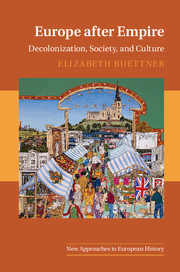Book contents
- Frontmatter
- Contents
- List of figures
- Acknowledgements
- Introduction
- Part I Decolonization for colonizers: Europe's transition to the postcolonial era
- 1 Myths of continuity and European exceptionalism: Britain, decolonization, and the Commonwealth family ideal
- 2 Occupation, resistance, and liberation: the road to Dutch decolonization
- 3 Soldiering on in the shadow of war: decolonizing la plus grande France
- 4 Long live the king? Belgium, the monarchy, and the Congo between the Second World War and the decolonization years
- 5 From rose-coloured map to Carnation Revolution: Portugal's overseas amputations
- Part II Migrations and multiculturalisms in postcolonial Europe
- Part III Memories, legacies, and further directions
- Epilogue: thoughts towards new histories of contemporary Europe
- Bibliography
- Index
2 - Occupation, resistance, and liberation: the road to Dutch decolonization
from Part I - Decolonization for colonizers: Europe's transition to the postcolonial era
Published online by Cambridge University Press: 05 June 2016
- Frontmatter
- Contents
- List of figures
- Acknowledgements
- Introduction
- Part I Decolonization for colonizers: Europe's transition to the postcolonial era
- 1 Myths of continuity and European exceptionalism: Britain, decolonization, and the Commonwealth family ideal
- 2 Occupation, resistance, and liberation: the road to Dutch decolonization
- 3 Soldiering on in the shadow of war: decolonizing la plus grande France
- 4 Long live the king? Belgium, the monarchy, and the Congo between the Second World War and the decolonization years
- 5 From rose-coloured map to Carnation Revolution: Portugal's overseas amputations
- Part II Migrations and multiculturalisms in postcolonial Europe
- Part III Memories, legacies, and further directions
- Epilogue: thoughts towards new histories of contemporary Europe
- Bibliography
- Index
Summary
Throughout the Second World War, the Dutch Cabinet remained closely attuned to the fate of the Netherlands within Europe and as an imperial power alike. Two of its most prominent members, Prime Minister Pieter Gerbrandy and Foreign Minister Eelco van Kleffens, wrote passionately both during and after the war about one part of the empire in particular: the East Indies. Territorially, the Kingdom of the Netherlands encompassed a small European nation in conjunction with the East Indies as well as the West Indies (which included Suriname on the mainland of South America along with Curaçao and other smaller islands of the Antilles in the Caribbean). But like most leading policymakers and commentators, Gerbrandy and Van Kleffens virtually ignored the western hemisphere and focused on the extensive Southeast Asian archipelago, whose collective population approximated 70 million and where Dutch control had originated over 300 years before. Although the Netherlands had also been present in the West Indies for centuries, the similarities ended there: by the mid-twentieth century, Dutch reflections on their nation's imperial past, present, and future had long looked east and rarely west, and the 1940s proved no different. Late in 1942 Van Kleffens discussed ‘The Democratic Future of the Netherlands Indies’ – apparently considering it so obvious that he meant the ‘East Indies’ he did not even bother with exact specification – as part of Queen Wilhelmina's government-in-exile based in London, where the monarch and her ministers had retreated in May 1940 when the Nazis invaded and occupied their homeland; Gerbrandy's book Indonesia appeared in 1950. Between them fell a series of watershed events, the end of the war, the end of the Netherlands East Indies, and the emergence of the Republic of Indonesia foremost among them.
Though penned under radically different circumstances and looking towards vastly different imagined futures, Van Kleffens’ and Gerbrandy's accounts exhibited a high degree of consensus about the East Indies up until 1942. Van Kleffens was the more critical, contrasting Dutch rule after 1900 favourably with the preceding period. Previous eras may have seen ‘colonial domination and economic exploitation for the benefit, first of the Dutch East India Company, then of the Dutch exchequer, and finally, under the liberal system of laissez-faire, of Dutch and foreign capitalism’ – which, he hastened to add, was nonetheless of considerable advantage to indigenous peoples.
- Type
- Chapter
- Information
- Europe after EmpireDecolonization, Society, and Culture, pp. 78 - 105Publisher: Cambridge University PressPrint publication year: 2016
- 1
- Cited by

